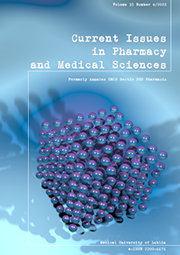A comparative review on High-Performance Liquid Chromatography (HPLC), Ultra Performance Liquid Chromatography (UPLC) & High-Performance Thin Layer Chromatography (HPTLC) with current updates
DOI:
https://doi.org/10.2478/cipms-2022-0039Keywords:
comparative, HPLC, UPLC, HPTLCAbstract
Any chosen analytical method should be subtle, precise, fast and exact to begin the guarantee that the material used in the manufacturing is free of unsolicited impurity, the existence of which may vary the safety and effectiveness of the drug product. The techniques of HPLC and UPLC have established their part in pharmaceutical cleaning validation. High-Performance Liquid Chromatography (HPLC) is the main pharmaceutical and biomedical analysis approach utilized today because it generates highly efficient separations, and in most circumstances, it provides high detection sensitivity. Applying the HPLC method has several advantages compared to other methods, among others, specificity, rapidity, accuracy, precision, and the ease of automation. Due to the aforementioned, most drugs in a multi-component dosage form can be analyzed. Ultra-Performance Liquid Chromatography (UPLC) is a modern-day technique that gives a new track for liquid chromatography. UPLC provides the user with speed of application, resolution and sensitivity. The quantification and separation in UPLC are done under very high pressure (up to 100M Pa). High-Performance Thin Layer Chromatography (HPTLC) has improved and innovative separation efficacy and detection limits. It is a cultured and automated form of Thin Layer Chromatography (TLC) and is based on the use of an optimized silica gel 60 with a significantly smaller particle size than which is used for TLC. The previously stated analytical methods are employed for purity control of chemicals, steroids, pesticides, and water analysis, water-soluble food dyes, vitamins, pesticides in vegetables, fruits, and other foodstuffs. The current updates in the techniques allow us to understand the increased utilization of these methods in the current eras.References
1. Rogatsky E. 2D or not 2D. Column-switching techniques, multidimensional separations and chromatography: Approaches and definitions. J Chromat Separation Techniq. 2012;03:08.
2. GmbH KWG. HPLC Principles and parameters. KNAUER. [https://www.knauer.net/en/Systems-Solutions/Analytical-HPLC-UHPLC/HPLC-Basics-principles-and-parameters] (access: 26.09.2022)
3. Basharat R, Kotra V, Loong LY, Mathews A, Kanakal MM, Devi CBP. A Mini-review on ultra performance liquid chromatography. Orient J Chem. 2021;37(4):847-57.
4. HPTLC instrumentation: an overview. PharmaTutor. [https://www.pharmatutor.org/articles/high-performance-thin-layer-chromatography-hptlc-instrumentation-overview] (access: 22.09.2022)
5. Chawla G, Ranjan C. Principle, Instrumentation, and applications of UPLC: A novel technique of liquid chromatography. Open Chem J. 2016;3(1).
6. Srivastava M. An Overview of HPTLC: A modern analytical technique with excellent potential for automation, optimization, hyphenation, and multidimensional applications. High-Performance Thin-Layer Chromatography (HPTLC). 2011:3-24. Review match
7. Mulubwa M, Rheeders MLD, Grobler A, Viljoen M. Development and validation of High Performance Liquid Chromatography Tandem Mass Spectrometry (HPLC-MS/MS) Method for determination of tenofovir in small volumes of human plasma. J Chromatogr Sep Tech. 2016;06(7).
8. Patel R, Patel M, Kashyap B, Patel B. Development and validation of HPTLC method for estimation of carbamazepine in formulations and its in vitro release study. Chromatogr Res Int. 2011; Article ID 684369.
9. Patil M. Chrominfo: Advantages and disadvantages of gas chromatography. Chrominfo. 2021. [https://chrominfo.blogspot.com/2019/03/advantages-and-disadvantages-of-gas.html] (access: 22.09.2022)
10. Swartz M, Krull I. Developing and validating stability-indicating methods. LC-GC North America. 2005;23:586-93.
11. Hemalatha K, Kistayya C, Nizamuddhin ND, Dastiagiriamma D. Simultaneous estimation of new analytical method development and validation of glecaprevir and pibrentasvir by High Performance Liquid Chromatography. Innov Int J Med Pharm Sci. 2018;3(Suppl.1): 5-8.
12. Fekete S, Schappler J, Veuthey JL, Guillarme D. Current and future trends in UHPLC. TrAC Trends in Analytical Chemistry. 2014;63:2-13. Review match
13. Chasset T, Häbe TT, Ristivojevic P, Morlock GE. Profiling and classification of French propolis by combined multivariate data analysis of planar chromatograms and scanning direct analysis in real time mass spectra. J Chromatogr A. 2016;1465:197-204.
Downloads
Published
Issue
Section
License
Copyright (c) 2023 Authors

This work is licensed under a Creative Commons Attribution-NonCommercial-NoDerivatives 3.0 Unported License.


